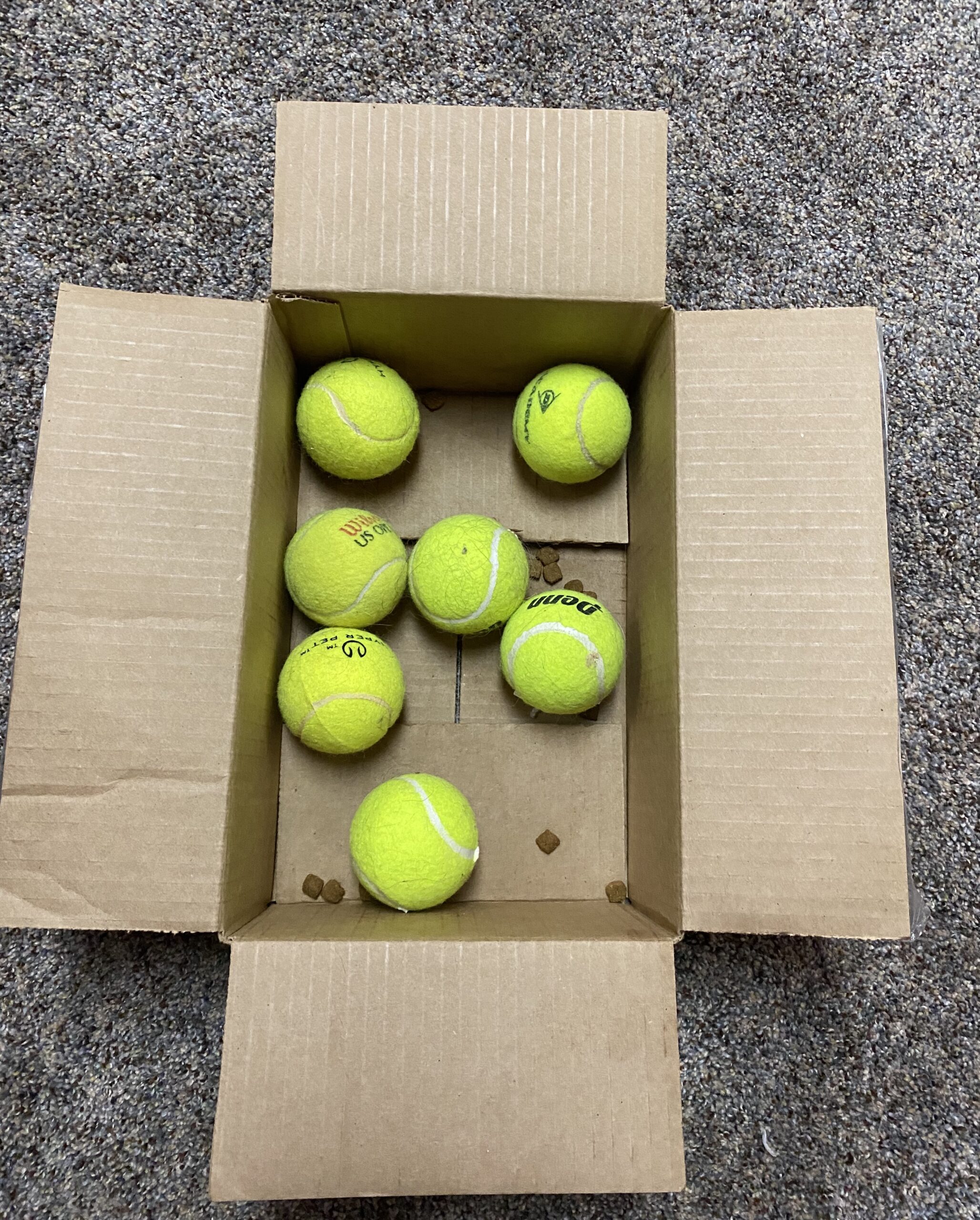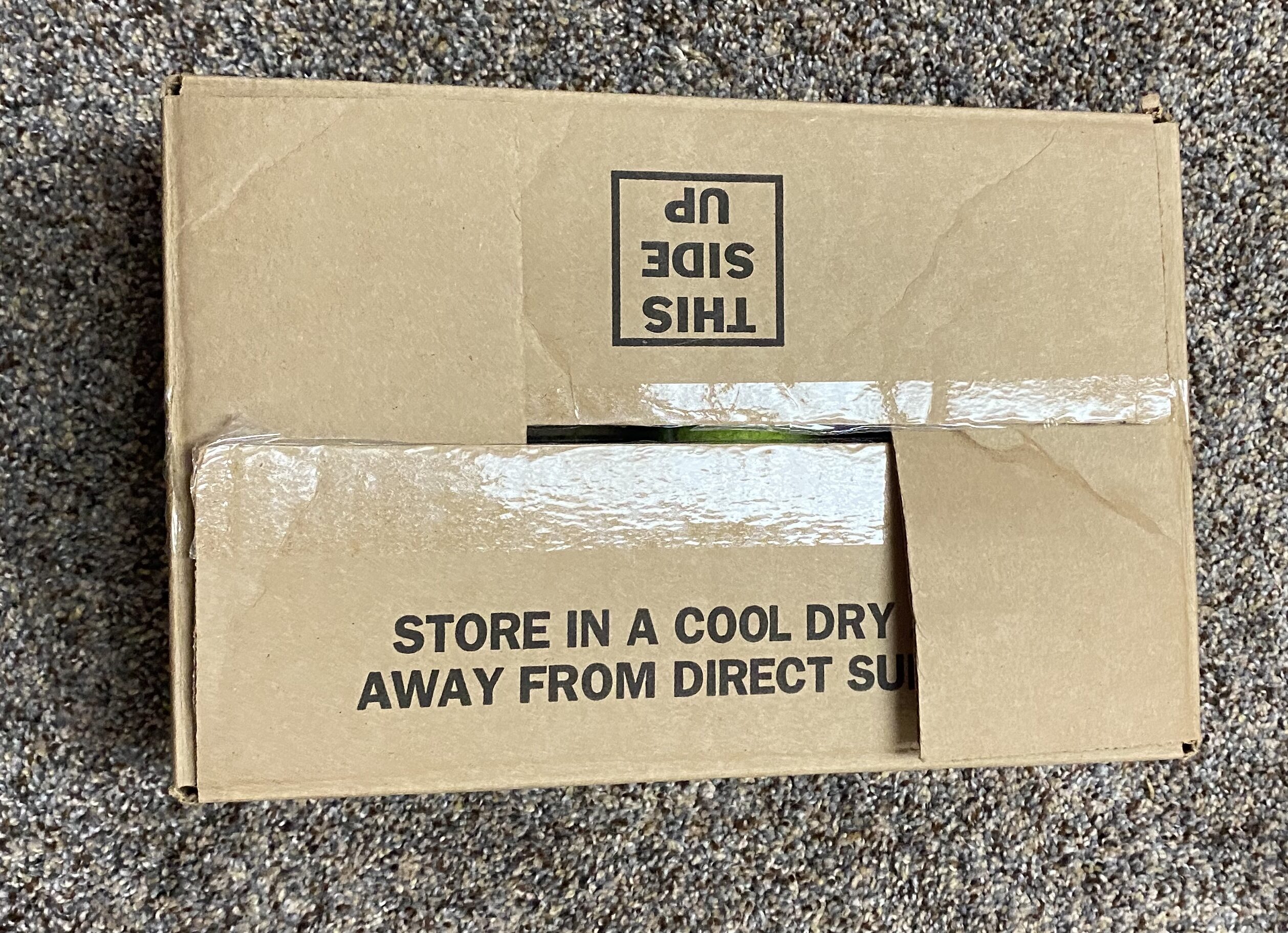While the box game is fantastic mental enrichment for any dog, it is particularly good for helping fearful dogs. They gain confidence as they explore new and novel objects, textures and surfaces.
Set up the game to accommodate your dog’s current ability and comfort level. Firstly, use several boxes of different sizes and shapes. Start out with different boxes set up at different levels of difficulty – see the levels below. After that, let your dog try the course. Take note of where he is confident and where he struggles. Adjust the course accordingly to set him up for success.
Each time you set up the course, keep some boxes at easy levels, some where your dog is confident or gaining confidence and one or two more challenging set ups. Then, if the dog is not comfortable with any of your set ups, take a moment to change things up to back off a bit on the difficulty level. Most important, use his body language as your guide to his level of comfort.
The box game can also be played with a single box. Adjust the difficulty as your dog gains confidence.
Always scatter some treats on the floor between and away from the boxes. This gives the dog the choice to opt out of exploring boxes and still has the opportunity to receive rewards. Requiring the dog to put his head into a box in order to gain a reward when he is scared to do so (or simply doesn’t want to) is coercive. Coercion has no place in dog training. Rather than speeding up the process, it will actually hamper your efforts to help your dog gain confidence.
Level 1: Upsidedown
Lay a medium-size box upside down on the floor. Put a couple of treats on the box and scatter treats around on the floor.
Move back and let your dog investigate at his own pace. If he is hesitant to take treats off the box, move them to the floor near the box. If the flaps are scaring him, fold them into the box.
Once he is able to take treats off of the top of the box, he is ready for Level 2.

Level 2: Box Game on its Side
Turn a box on its side and place a treat on top of the box and on the edge of the bottom lip of the box. If the dog is nervous about the flaps of the box, you can fold those inside until a later step. If the dog is able to take a treat from the lower lip of the box, try moving the treat farther and farther into the interior of the box.
This level may be easier with a larger box to begin with – especially if the flaps are sticking out. If the box is small, the dog will have to brush his head along the top flap as he reaches in to pick up the treat.
As the dog gains confidence, you can decrease the size of the box. You can even fold the top flap down a bit so that it partially obstructs the interior of the box. We are working toward your dog being comfortable reaching into the box and brushing the flaps with confidence.


Level 3: Reaching Inside
At this stage, we are asking the dog to reach into a box to get his reward. Start with a box that is low enough that your dog can reach in and touch the bottom of the box without needing to touch the sides of the box or lean into the box. The flaps are folded in at this point. If the dog is worried about reaching into a box with solid sides, you can use a basket or hamper.
As the dog gains confidence, you can start using larger, taller boxes that require the dog to lean into the box to reach the bottom.
When your dog is reaching into the box with confidence and pushing it across the floor to get all of the treats, he is ready to move to the next level.


Level 4: Flaps Out
One by one, fold the flaps out. Eventually all the flaps are sticking out and the dog will need to touch a flap in order to reach into the box.


Level 5: Adding Elements
The next level of difficulty for the box game is adding items to the box. Start with a single familiar item that you dog will not be afraid to move around with his nose in order to reach the treats. As your dog gains confidence, add more items – even novel items.






Level 6: Flaps In
Start folding the flaps inward so that they brush the dog’s head and face as he reaches into the box and as he pulls his head back out.



The Ultimate Box Game
Lock the flaps and let your dog work at getting into the box.
Some dogs will stick their head into the box and pull his head out to open the flaps. Other dogs will use their paws to open the box. Still others will dive right in and start ripping up the box to get inside. Any and all methods are acceptable.

Caution: If your dog is a box shredder, keep an eye on him to make sure he is not eating large pieces of the box. Avoid sticky and wet treat items to prevent scent and moisture from seeping into the cardboard – this can encourage the dog to ingest cardboard.
The Exploratory Box Game

Use a box, basket or hamper that your dog is comfortable with. Fill it with new and novel objects, textures and surfaces. Different types of balls (soft, fuzzy, rubber, textured, prickly, squeaky, etc.), stuffies, squeaky toys, rope toys, frisbee, crinkly items like water bottles or packing paper, etc. Chew toys like antlers, synthetic bones, bully stick, etc.
Let the dog explore as he chooses. If he pulls out a toy, take the time to play with him and his new treasure.

Kerrie Hoar, M.S., CDBC, CPDT-KA, ADT, FFCP
Kerrie Hoar has a master’s degree in Biology and is a certified dog behavior consultant, certified professional dog trainer and fear free professional. She owns Crimson Hound LLC dog training in La Crosse, Wisconsin.

